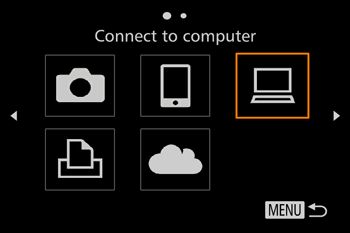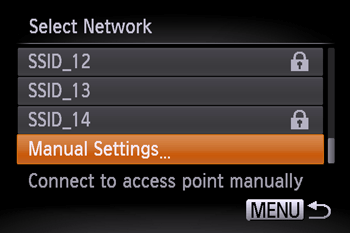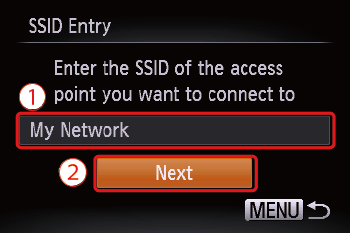Sending images to a computer (Wi-Fi function)
20-Apr-2017
8202436100
Solusi
To connect the camera to the computer using the Wi-Fi function, confirm that the computer is connected to an access point (Wi-Fi router).
IMPORTANT
La posición y la forma de los botones de funcionamiento, las pantallas mostradas y los elementos de configuración pueden variar según el modelo que utilice.

1. Check the computer`s specifications.
For the computer environments supporting Wi-Fi connection function, refer to the Related Information section at the end of the page.
IMPORTANT
- Windows 7 Starter and Home Basic editions are not supported.
- Windows 7 N (European version) and KN (South Korean version) require a separate download and installation of Windows Media Feature Pack.
2. Confirm that an access point base unit (Wi-Fi router, etc.) is connected to the computer.
3. Make sure that the included CameraWindow* software is installed.
*The software is available for download from the Canon website.
NOTE
- A router is a device that creates a network (LAN) structure for connecting multiple computers. A router that contains an internal Wi-Fi function is called a "Wi-Fi router".
- This page will refer to all Wi-Fi routers and base stations as "access points".
- When unsure of your computer setup, refer to the user manual provided with the computer.
Even if your computer is connected to an access point, sending images from the camera to the computer requires changing the computer`s settings. The procedure is explained below.
Windows 7 users, proceed to 2A: Windows 7
Windows 8 users, proceed to 2B: Windows 8
Mac users, proceed to Step 3: Connecting the camera to a computer.
- 2A: Windows 7
2A-1. In the Start menu, click [All Programs] > [Canon Utilities].

2A-2. Click [CameraWindow] > [Wi-Fi connection setup].

2A-3. A screen similar to the one below will be displayed. Click [Yes].

2A-4. The following screen appears.

This concludes the steps for connecting a computer to a wireless LAN.
Please proceed to Step 3: Connecting the camera to a computer.- 2B: Windows 8
2B-1.  Move the pointer to the bottom right of the screen to display the Charms, and then
Move the pointer to the bottom right of the screen to display the Charms, and then  select [Start].
select [Start].
 Move the pointer to the bottom right of the screen to display the Charms, and then
Move the pointer to the bottom right of the screen to display the Charms, and then  select [Start].
select [Start].
2B-2. Click [Wi-Fi Connection Set-up] on the Start menu.

2B-3. A screen similar to the one below will be displayed. Click [Yes].

2B-4. The following screen appears.

This completes the Wi-Fi setting procedure for the computer.
Please proceed to Step 3: Connecting the camera to a computer.1. Press the <Playback> ( ) button to turn the camera on.
) button to turn the camera on.
 ) button to turn the camera on.
) button to turn the camera on.2. Press the <Wi-Fi> ( ) button.
) button.
 ) button.
) button.
NOTE
When setting up Wi-Fi for the first time, the camera nickname registration screen will be displayed.
This nickname will be displayed on the screen of target devices when connecting to other devices via Wi-Fi.

Press the [  ] button to display the keyboard, and use it to enter a nickname for the camera.
] button to display the keyboard, and use it to enter a nickname for the camera.
 ] button to display the keyboard, and use it to enter a nickname for the camera.
] button to display the keyboard, and use it to enter a nickname for the camera.*You can change the device nickname (display name) that is displayed on the camera. To change the nickname, press the [  ] button and use the keyboard displayed to enter a new nickname.
] button and use the keyboard displayed to enter a new nickname.
 ] button and use the keyboard displayed to enter a new nickname.
] button and use the keyboard displayed to enter a new nickname.3. Press the [  ], [
], [  ], [
], [  ], [
], [  ] buttons to choose (
] buttons to choose ( ), and then press the [
), and then press the [  ] button.
] button.
 ], [
], [  ], [
], [  ], [
], [  ] buttons to choose (
] buttons to choose ( ), and then press the [
), and then press the [  ] button.
] button.

4. Press the [  ], [
], [  ] buttons to choose [Add a Device], and then press the [
] buttons to choose [Add a Device], and then press the [  ] button.
] button.
 ], [
], [  ] buttons to choose [Add a Device], and then press the [
] buttons to choose [Add a Device], and then press the [  ] button.
] button.
NOTE
Once a computer is added, the computer name will be displayed on the screen in 4. To connect to a computer again, simply choose the computer name from the list.
5. A list of detected access points will be displayed in the [Access Point Connect] screen.
Use the following method to connect with an access point.
•5A Connecting to WPS-Compatible Access Points.
•5B Connecting to Access Points in the List.
•5C Connecting to an access point manually.
•5B Connecting to Access Points in the List.
•5C Connecting to an access point manually.
NOTE
- WPS makes it easy to complete settings when connecting devices over Wi-Fi. You can use either Push Button Configuration Method or PIN Method for settings on a WPS supported device. The push button configuration method is used in the following explanation.
- Refer to the user guide provided with your access point to check if it supports WPS.
- 5A Connecting to WPS-Compatible Access Points.
5A-1. Press the [  ], [
], [  ] buttons to choose [WPS Connection], and then press the [
] buttons to choose [WPS Connection], and then press the [  ] button.
] button.
 ], [
], [  ] buttons to choose [WPS Connection], and then press the [
] buttons to choose [WPS Connection], and then press the [  ] button.
] button.
5A-2. Press the [  ], [
], [  ] buttons to choose [PBC Method], and then press the [
] buttons to choose [PBC Method], and then press the [  ] button.
] button.
 ], [
], [  ] buttons to choose [PBC Method], and then press the [
] buttons to choose [PBC Method], and then press the [  ] button.
] button.
5A-3. On the access point, hold down the WPS connection button for a few seconds. On the camera, press the [  ] button.
] button.
 ] button.
] button.
- The camera will connect to the access point.
- A list of computers connected to the access point will appear in the [Select a Device] screen.
NOTE
A WPS connection button is affixed to your access point (Wireless LAN, router, etc.). For further details on the location and how many seconds to press it, refer to the user guide included with your access point.

5A-4. When a connectible device is found, a screen like the one below will appear.
Touch the name of the computer you want to connect with.

A screen like the one below will appear.

Please proceed to Step 4: Sending images to a computer.
•For Windows users, when connecting your camera to your computer wirelessly for the first time, the display will not change during connection.
Please proceed to 6. Driver Installation.
- 5B Connecting to Access Points in the List
5B-1. The access point's password (encryption key / network key) is necessary for connection. To determine the access point password, check on the access point itself or refer to the user manual.
NOTE
- Password (encryption key / network key)
-The key used when encrypting data during wireless transmission. Also called the "encryption key" or "network key".
5B-2. Press the [  ], [
], [  ] buttons to choose a network (access point), and then press the [
] buttons to choose a network (access point), and then press the [  ] button.
] button.
 ], [
], [  ] buttons to choose a network (access point), and then press the [
] buttons to choose a network (access point), and then press the [  ] button.
] button.
5B-3.  Press the [
Press the [  ] button to access the keyboard, and then enter the encryption key,
] button to access the keyboard, and then enter the encryption key,  Choose [Next], and press the [
Choose [Next], and press the [  ] button.
] button.
 Press the [
Press the [  ] button to access the keyboard, and then enter the encryption key,
] button to access the keyboard, and then enter the encryption key,  Choose [Next], and press the [
Choose [Next], and press the [  ] button.
] button.
5B-4. Press the [  ], [
], [  ] buttons to choose [Auto] and press the [
] buttons to choose [Auto] and press the [  ] button.
] button.
 ], [
], [  ] buttons to choose [Auto] and press the [
] buttons to choose [Auto] and press the [  ] button.
] button.
5B-5. A list of devices connected to the access point will appear on the screen.
Press the [  ], [
], [  ] buttons to choose the name of the computer you want to connect to, and then press the [
] buttons to choose the name of the computer you want to connect to, and then press the [  ] button.
] button.
 ], [
], [  ] buttons to choose the name of the computer you want to connect to, and then press the [
] buttons to choose the name of the computer you want to connect to, and then press the [  ] button.
] button.
A screen like the one below will appear.

•If you are using Mac or Windows with the drivers installed, the screen will turn off after the connection is terminated.
Please proceed to Step 4: Sending images to a computer.
•For Windows users, when connecting your camera to your computer wirelessly for the first time, the display will not change during connection.
Please proceed to 6. Driver Installation.
Please proceed to Step 4: Sending images to a computer.
•For Windows users, when connecting your camera to your computer wirelessly for the first time, the display will not change during connection.
Please proceed to 6. Driver Installation.
- 5C Connecting to an access point manually.
5C-1. The access point`s SSID/ESSID, security method, and password (encryption key / network key) are all necessary for connection. Refer to the user guide included with your access point to look up information on SSID/ESSID, Security method/encryption method, and password (encryption key / network key).
NOTE
- The network name (SSID/ESSID) is the SSID or ESSID for the access point you use. Also called the "access point name" or "network name".
- Security method/encryption method is the method for encrypting data during wireless transmission.
- The password (encryption key / network key) is the key used when encrypting data during wireless transmission. Also called the "encryption key" or "network key".
5C-2. Press the [  ], [
], [  ] buttons to choose [Manual Settings] and press the [
] buttons to choose [Manual Settings] and press the [  ] button.
] button.
 ], [
], [  ] buttons to choose [Manual Settings] and press the [
] buttons to choose [Manual Settings] and press the [  ] button.
] button.
5C-3.  Press the [
Press the [  ] button and enter the SSID/ESSID key on the displayed keyboard.
] button and enter the SSID/ESSID key on the displayed keyboard.  Choose [Next] and press the [
Choose [Next] and press the [  ] button.
] button.
 Press the [
Press the [  ] button and enter the SSID/ESSID key on the displayed keyboard.
] button and enter the SSID/ESSID key on the displayed keyboard.  Choose [Next] and press the [
Choose [Next] and press the [  ] button.
] button.
5C-4. Choose the Security method/encryption method.

5C-5.  Press the [
Press the [  ] button to access the keyboard, and then enter the encryption key.
] button to access the keyboard, and then enter the encryption key.  Choose [Next], and then press the [
Choose [Next], and then press the [  ] button.
] button.
 Press the [
Press the [  ] button to access the keyboard, and then enter the encryption key.
] button to access the keyboard, and then enter the encryption key.  Choose [Next], and then press the [
Choose [Next], and then press the [  ] button.
] button.
5C-6. Press the [  ], [
], [  ] buttons to choose [Auto], and then press the [
] buttons to choose [Auto], and then press the [  ] button.
] button.
 ], [
], [  ] buttons to choose [Auto], and then press the [
] buttons to choose [Auto], and then press the [  ] button.
] button.
5C-7. When a device is found, a screen like the following will appear.
Choose the name of the computer you want to connect to, and then press the [  ] button.
] button.
 ] button.
] button.
A screen like the following will appear.

•If you are using Mac or Windows with the drivers installed, the screen will turn off after the connection is terminated.
Please proceed to Step 4: Sending images to a computer.
•For Windows users, when connecting your camera to your computer wirelessly for the first time, the display will not change during connection.
Please proceed to 6. Driver Installation.
Please proceed to Step 4: Sending images to a computer.
•For Windows users, when connecting your camera to your computer wirelessly for the first time, the display will not change during connection.
Please proceed to 6. Driver Installation.
When wirelessly connecting the camera to a computer for the first time, it is necessary to install the drivers using the following procedure (Windows Only).
7. Make sure the below screen appears on the camera`s display.

7A-1. Windows 7
When the screen in step 7 is shown on the camera’s LCD panel, click the computer's Start menu and choose [Control Panel] > [Network and Internet] > [View network computers and devices], and then choose the connected camera from [Other Devices] and then double click the camera icon. Driver installation will begin.

7A-2. After driver installation is complete, and the camera and computer connection is enabled, the AutoPlay screen will be displayed.
Nothing will be displayed on the camera screen.
Click [Download Images From Canon Camera].

Nothing will be displayed on the camera screen.
Click [Download Images From Canon Camera].

7B-1. Windows 8
When the screen in step 7 is shown on the camera’s LCD panel, move the computer’s pointer to the bottom right side of the desktop to display the Charms, and then click [Settings] > [Control Panel] > [Add a Device].

7B-2. The camera’s icon will be displayed in the [Add a device] screen.
Double-click the icon to begin driver installation.

7B-3. When the connection between the camera and the computer has been established, a screen like the following will appear.
Click [Tap to choose what happens with this device].
Nothing will be displayed on the camera’s LCD panel.

7B-4. Click [Downloads images from Canon camera].

1. The CameraWindow menu window will be displayed, so click [Import Images from Camera].

2. A window like the one shown below will appear, so click  [Import Untransferred Images],
[Import Untransferred Images],  [Select Images to Import], or
[Select Images to Import], or  [Import All Images].
[Import All Images].
 [Import Untransferred Images],
[Import Untransferred Images],  [Select Images to Import], or
[Select Images to Import], or  [Import All Images].
[Import All Images].
3. If you chose [Select Images to Import] in Step 2,  select the images you want to import, and then click
select the images you want to import, and then click  [Import] (
[Import] ( ).
).
 select the images you want to import, and then click
select the images you want to import, and then click  [Import] (
[Import] ( ).
).
4. The following window will appear, and the computer will start to transfer images from the camera.

5. After the images have been imported, the display returns to the screen shown in step 1. When you are finished importing, click [  ] to close the screen.
] to close the screen.
 ] to close the screen.
] to close the screen.NOTE
- CameraWindow default settings will save images to the Pictures or My Pictures folders on a computer.
- Movies will take longer to import since the file size is larger than still images.
- To disconnect from the camera, turn off the camera.